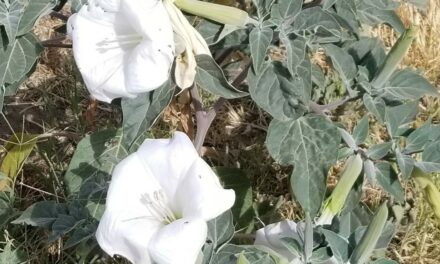Roses, bougainvillea, black-eyed Susans or any of dozens of plants that sport bright colors in the summer attract a particular genus of bee which one could swear wields a hole punch as it races from plant to plant.
Any of 77 species of large leaf-cutter bees (Megachile x.) living in California can turn a solid rose leaf into a see-through in seconds and fray bougainvillea bracts to the point where only the plants tubular white flower is left standing.
Few have ever seen the bee as it cuts circular holes because the critter is quick at its work, so fast in fact that it is buzzing for take-off just as the last bit of plant is snipped away. While plants donating parts of their leaves to the next generation of leaf-cutters may look ragged they are unharmed by the bee’s harvesting.
Females of the bee species do the leaf cutting and use what they cut free to line a nest cell for a single egg they will lay. In the cell, lined with plenty of cuttings, the bee will place a ball of nectar and pollen to sustain the larval form of the insect once the egg hatches. All of it will be sealed inside a small tunnel in a piece of rotted wood, a hollow plant stem such as rose cane or even in an abandoned beetle tunnel.
It’s important that the bee gets nest building right because most of the insect’s life will be spent in the nest as a larva. It emerges ready to fly in the spring when it mates and, if a female, begins pollinating, cutting and collecting. Male bees emerge from the nest first but die soon after mating.
Females have large mandibles to facilitate leaf cutting and a stinger she will use if threatened. Unlike a honeybee’s stinger the leaf cutter’s is not barbed and can be used multiple times if necessary. Its sting is not nearly as painful as that of a honeybee and magnitudes less traumatizing than a wasp’s.
With few exceptions, leaf-cutters are generalist foragers, pollinating a variety of plants. The Alfalfa leaf-cutter bee (M. rotundata) is an introduced species that specializes in pollinating commercial alfalfa crops. There are some of the genus that prefer flowers from the family Asteraceae, but for most pollen is pollen, and nectar is nectar regardless of the source.
Large leaf-cutter bees are smaller than European honeybees (Apis mellifera) but larger than small leaf-cutter bees (Osmia x.) or mason bees. They are superior pollinators flying flower to flower at a faster rate than the honeybee and collecting pollen on the long hairs on its abdomen (scopa) like bumble bees instead of on its legs like the European buzzers.
Leaf-cutters are solitary bees and thrive in the heat of summer. As days grow shorter and cooler, leaf cutting and nest building stop, leaving what pollen and nectar remain to the honey and carpenter bees.
While leaf-cutter bees are an example of wildlife one might find in their own backyard, look for signs of their telltale leaf cutting while walking along a nature trail at one of the local national wildlife refuges.
The San Luis National Wildlife Refuge, Merced National Wildlife Refuge and the San Joaquin River National Wildlife Refuge comprise the San Luis National Wildlife Refuge Complex. Its headquarters and visitor center are located just north of Los Banos off Highway 165 at 7376 South Wolfsen Road. The refuges are open to visitors daily from one half-hour before sunrise to one half-hour after sunset. The visitor center is generally open Monday through Friday except federal holidays from 8 a.m. to 4 p.m.

